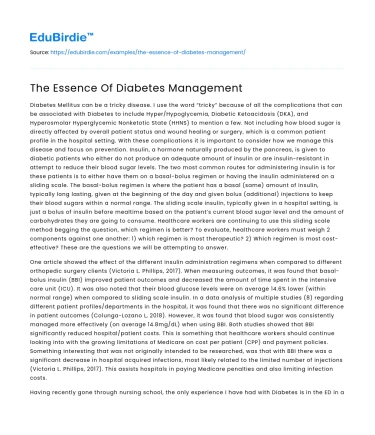Diabetes Mellitus can be a tricky disease. I use the word “tricky” because of all the complications that can be associated with Diabetes to include Hyper/Hypoglycemia, Diabetic Ketoacidosis (DKA), and Hyperosmolar Hyperglycemic Nonketotic State (HHNS) to mention a few. Not including how blood sugar is directly affected by overall patient status and wound healing or surgery, which is a common patient profile in the hospital setting. With these complications it is important to consider how we manage this disease and focus on prevention. Insulin, a hormone naturally produced by the pancreas, is given to diabetic patients who either do not produce an adequate amount of insulin or are insulin-resistant in attempt to reduce their blood sugar levels. The two most common routes for administering insulin is for these patients is to either have them on a basal-bolus regimen or having the insulin administered on a sliding scale. The basal-bolus regimen is where the patient has a basal (same) amount of insulin, typically long lasting, given at the beginning of the day and given bolus (additional) injections to keep their blood sugars within a normal range. The sliding scale insulin, typically given in a hospital setting, is just a bolus of insulin before mealtime based on the patient’s current blood sugar level and the amount of carbohydrates they are going to consume. Healthcare workers are continuing to use this sliding scale method begging the question, which regimen is better? To evaluate, healthcare workers must weigh 2 components against one another: 1) which regimen is most therapeutic? 2) Which regimen is most cost-effective? These are the questions we will be attempting to answer.
One article showed the effect of the different insulin administration regimens when compared to different orthopedic surgery clients (Victoria L. Phillips, 2017). When measuring outcomes, it was found that basal-bolus insulin (BBI) improved patient outcomes and decreased the amount of time spent in the intensive care unit (ICU). It was also noted that their blood glucose levels were on average 14.6% lower (within normal range) when compared to sliding scale insulin. In a data analysis of multiple studies (8) regarding different patient profiles/departments in the hospital, it was found that there was no significant difference in patient outcomes (Colunga-Lozano L, 2018). However, it was found that blood sugar was consistently managed more effectively (on average 14.8mg/dL) when using BBI. Both studies showed that BBI significantly reduced hospital/patient costs. This is something that healthcare workers should continue looking into with the growing limitations of Medicare on cost per patient (CPP) and payment policies. Something interesting that was not originally intended to be researched, was that with BBI there was a significant decrease in hospital acquired infections, most likely related to the limited number of injections (Victoria L. Phillips, 2017). This assists hospitals in paying Medicare penalties and also limiting infection costs.
Save your time!
We can take care of your essay
- Proper editing and formatting
- Free revision, title page, and bibliography
- Flexible prices and money-back guarantee
Having recently gone through nursing school, the only experience I have had with Diabetes is in the ED in an acute situation or in Med/Surg where it seems “everyone” has Diabetes. I thought that sliding scale insulin was simply the best way to manage blood sugar levels from all of the injections that I have given without question. Now that I have read these articles, I am more aware of Diabetes management. I now realize that, maybe not including patients in acute hyperglycemic states, that hospitals should be moving more towards a BBI system to manage Diabetes for the patients benefit and for the benefit of the hospital. I would certainly recommend this article to other healthcare providers. I think that it is so easy to let certain practices go unchecked without question. If anything, I would hope that this article would cause nurses and certain physicians to question their treatment plans instead of falling into old habits. It can only benefit them and the patient, why not question the norm? I do believe that a transition into making BBI the standard of diabetic care should be proceeded with caution as there is still not many trials to confirm that this is the best form of care in all healthcare settings. We can confirm from this article that BBI is effective in orthopedic surgery clients, but I would need to continue researching how it affects other hospital departments in order to confidently say it should become the standard of care. Like I said, I would only hope that reading this article would cause other nurses to question their diabetic treatment routines and that is what I hope to take with me into my career. There are so many patients in the hospital setting that I see with Diabetes and I just hope not to grow numb to looking at each patient situation individually.
Did you like this example?
Make sure you submit a unique essay
Our writers will provide you with an essay sample written from scratch: any topic, any deadline, any instructions.
Cite this paper
-
APA
-
MLA
-
Harvard
-
Vancouver
The Essence Of Diabetes Management.
(2022, March 17). Edubirdie. Retrieved December 22, 2024, from https://edubirdie.com/examples/the-essence-of-diabetes-management/
“The Essence Of Diabetes Management.” Edubirdie, 17 Mar. 2022, edubirdie.com/examples/the-essence-of-diabetes-management/
The Essence Of Diabetes Management. [online].
Available at: <https://edubirdie.com/examples/the-essence-of-diabetes-management/> [Accessed 22 Dec. 2024].
The Essence Of Diabetes Management [Internet]. Edubirdie.
2022 Mar 17 [cited 2024 Dec 22].
Available from: https://edubirdie.com/examples/the-essence-of-diabetes-management/
copy






 Stuck on your essay?
Stuck on your essay?

